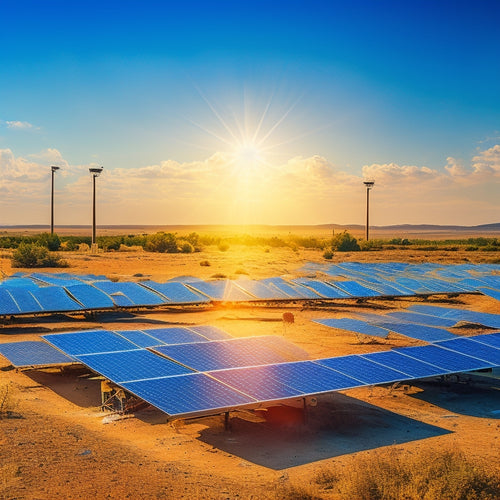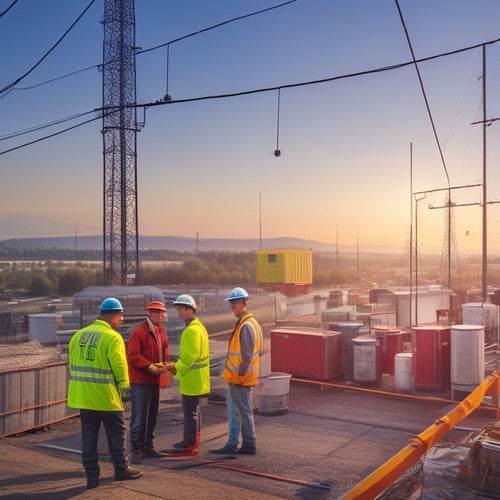
What's Wrong With Your Solar System?
Share
Your solar system might be underperforming due to suboptimal panel angles, shading obstacles, and inadequate energy storage solutions, ultimately reducing your energy independence and renewable energy contribution. You may be losing up to 10% of energy production due to seasonal misalignment or fixed panel angles. Shading from trees, buildings, or roof obstructions can drastically decrease energy output, and insufficient energy storage can leave you reliant on the grid at night. By addressing these common issues, you can reveal your solar system's full potential. A closer look at your system's performance will reveal opportunities for improvement, and just by exploring further, you'll discover the path to maximizing your energy harvest.
At a Glance
- Inefficient panel angles and orientations can significantly reduce energy harvesting potential, leading to subpar solar system performance.
- Shading effects from trees, buildings, and roof obstructions can drastically decrease solar system energy output, impacting overall efficiency.
- Inadequate energy storage solutions can leave homeowners without power during low sunlight periods, undermining energy independence.
- Inverter technology inefficiencies, such as poor Maximum Power Point Tracking, can result in reduced energy production and system downtime.
- Failure to perform regular system maintenance and monitoring can lead to undetected issues, reducing solar system lifespan and overall performance.
Maximize Energy Harvesting Potential
You can markedly enhance your solar system's energy production by optimizing panel angles to match your location's solar path.
By leveraging state-of-the-art Solar Panel Technology, you can guarantee maximum energy conversion rates.
Additionally, reducing shading effects from trees, buildings, or other obstructions is essential to minimize energy losses.
Optimize Panel Angles
The angle at which solar panels are installed greatly impacts their energy harvesting potential. You must consider the ideal panel orientation to maximize energy production. In the Northern Hemisphere, a south-facing orientation is optimal, as it receives the most direct sunlight throughout the year.
When investing in solar installation, it's crucial to find a reliable and trustworthy solar installation service provider that can guarantee quality workmanship and long-term system efficiency Professional Panel Installations. Additionally, many shoppers struggle to find clarity on how to maneuver through the complex installation process, which can lead to costly mistakes.
However, you should also consider seasonal adjustments to enhance energy harvesting. During winter, a steeper angle can help capture more sunlight, while a shallower angle is better suited for summer.
You can adjust the panel angle seasonally to compensate for the changing sun path. A good rule of thumb is to tilt your panels at an angle equal to your latitude during winter and subtract 15 degrees during summer. This adjustment can increase energy production by up to 10%.
Additionally, you can install a tracking system that automatically adjusts the panel angle to follow the sun's movement, further enhancing energy harvesting. By fine-tuning your panel angles, you can reveal your solar system's full potential and enjoy greater energy independence.
Reduce Shading Effects
Six primary obstacles can hinder your solar system's energy harvesting potential, and shading effects rank high on that list. Shading can considerably reduce your system's overall energy output, making it essential to identify and address these issues.
By investing in professional renewable energy solutions, such as Solar Power Installation, homeowners and businesses can guarantee their systems are refined for maximum energy harvesting. You can implement shading solutions by evaluating your tree management strategy, adjusting panel placement, and making seasonal adjustments to enhance energy harvesting.
Additionally, incorporating reflective surfaces into your design can help maximize energy output. Installing shading devices, such as solar screens or louvers, can also help mitigate shading effects.
Conducting a thorough sunlight analysis will help you identify areas where shading occurs and inform your decisions on ideal landscaping. By understanding local weather patterns and adjusting your system accordingly, you can minimize shading effects and maximize your energy harvesting potential.
Increased Energy Independence
Your solar system should provide a renewable energy source, reducing your reliance on the grid.
By generating your own power, you'll need less energy from external sources, increasing your energy independence.
With efficient and durable house solar panels, you can maximize your energy output.
This means you'll have more control over your energy costs and usage, making you less susceptible to rate hikes and outages.
Renewable Energy Source
Utilizing solar energy reduces reliance on fossil fuels, an essential step towards increased energy independence.
You're not only breaking free from the grip of foreign oil but also contributing to a cleaner environment. With advancements in solar panel technology, you can capture the sun's energy more efficiently than ever.
The benefits of renewable energy are undeniable, including reduced greenhouse gas emissions and lower operating costs. However, you'll need energy storage solutions to guarantee a steady supply when the sun isn't shining.
Grid integration challenges must be addressed to facilitate the seamless transfer of power. An environmental impact assessment will help you identify areas for improvement.
Fortunately, government incentives and community solar programs can offset the initial investment. By staying up-to-date with the latest solar energy trends and implementing energy efficiency strategies, you'll be well on your way to mitigating climate change.
Reduced Reliance Needed
As the world grapples with the challenges of climate change, energy security, and economic instability, reducing reliance on fossil fuels becomes increasingly important.
You need a solar system that can provide increased energy independence. To achieve this, you must prioritize energy storage, guaranteeing you have a reliable backup during periods of low sunlight.
Regular system maintenance is also essential to optimize performance and extend the lifespan of your solar panels. Conducting a thorough cost analysis will help you identify areas for improvement and potential savings.
When installing your system, follow expert tips to guarantee a seamless grid connection. Performance monitoring is critical to track your energy output and identify opportunities for system upgrades.
Investing in advanced battery technology will enhance your energy management capabilities, allowing you to store excess energy for later use.
Efficient Inverter Technology Explained
You're likely aware that your solar system's inverter plays a vital role in converting DC power from your panels into usable AC power for your home, especially when considering a DIY solar kit for a more personalized approach.
To guarantee peak performance, it's important to understand the significance of a well-designed mounting system.
To maximize energy harvest, your inverter relies on Maximum Power Point Tracking (MPPT) to continuously monitor and adjust to the best power output of your panels.
High-Frequency Conversion Efficiency is also significant, as it directly impacts the amount of energy your system can produce while minimizing losses.
Maximum Power Point Tracking
Your solar system's inverter is only as good as its ability to maximize energy harvesting, and that's where Maximum Power Point Tracking (MPPT) comes in. MPPT is an essential feature that guarantees your inverter operates at the highest possible efficiency, optimizing solar efficiency and energy production.
This advanced technology uses sophisticated tracking algorithms to identify the maximum power point of your solar panels, guaranteeing the inverter extracts the most energy possible.
MPPT's energy balance feature constantly monitors your system's performance, adjusting to changes in panel orientation, weather impact, and load management. This real-time monitoring enables system diagnostics, allowing you to identify and address any issues promptly.
Regular maintenance practices are also simplified, as MPPT provides performance monitoring and alerts you to potential problems. By optimizing energy harvesting, MPPT reduces the strain on energy storage, guaranteeing a stable and reliable power supply.
With MPPT, you can rest easy that your solar system is operating at its best, giving you the freedom to enjoy clean, renewable energy.
High-Frequency Conversion Efficiency
The heart of your solar system's inverter, the high-frequency conversion stage, plays an imperative role in energy harvesting. This stage is responsible for converting the DC power generated by your solar panels into AC power, which is usable in your home.
However, high-frequency conversion poses significant challenges. High frequency impacts the overall efficiency of your solar system. As the frequency increases, so do the switching losses, leading to heat generation and reduced conversion efficiency.
Furthermore, high-frequency conversion requires advanced materials and complex circuit designs, which increase the cost and complexity of the inverter.
To overcome these conversion challenges, efficient inverter technology is vital. Advanced topologies, such as resonant converters and multilevel inverters, can help minimize switching losses and maximize conversion efficiency.
Additionally, the use of high-frequency switching devices, like gallium nitride (GaN) transistors, can reduce energy losses and increase the power density of the inverter. By leveraging these technologies, you can guarantee that your solar system operates at its full potential, providing you with clean, reliable, and efficient energy.
Assess Your Roof's Shading
You need to identify roof obstructions that can cast shade on your solar panels, including skylights, vents, and chimneys, as they can greatly reduce energy production.
By utilizing the power of solar for a greener home renewable energy solutions and considering energy efficiency, you can maximize your solar system's performance.
Conducting a shading pattern analysis will help you determine the impact of these obstructions on your solar system's performance.
Roof Obstructions to Consider
Shading from obstructions on your roof can considerably reduce your solar system's energy output. When evaluating your roof's shading, consider the various obstructions that may impact your solar panels' performance.
Start by reviewing the roof materials and their impact on your solar system. For instance, a metal roof may require specialized installation equipment, adding to the overall cost.
Furthermore, installation challenges can arise when dealing with complex roof geometries or multiple skylights. The orientation of your roof also plays an essential role, as a north-facing roof may not be ideal for solar panel installation.
Verify that your roof's structural integrity can support the weight of the solar panels, and consider potential maintenance issues that may arise. Additionally, familiarize yourself with local regulations and weather considerations, such as high winds or heavy snow loads, that may affect your solar system.
Shading Pattern Analysis
To guarantee peak solar panel performance, evaluating your roof's shading patterns is a critical step.
You need to assess how shading impacts your solar performance throughout the day and year. Consider seasonal variations in shading, as trees and foliage change with the seasons. Shading mitigation strategies, such as pruning trees or installing panels at an angle, can help minimize the effect.
Your roof's orientation, weather influences, and surrounding surroundings effects all play a role in shaping your shading patterns.
A thorough shading analysis will help you identify the best solar panel placement to maximize energy yield.
Don't assume that a single panel placement will work for your entire roof – different sections may require unique approaches.
Higher Efficiency at Night
You're likely aware that your solar panels generate most of their power during the day, but did you know that some systems can maximize power even in darkness?
This is possible due to the ability of certain systems to capture energy from the Earth's thermal mass, allowing them to continue generating power at night.
Max Power in Darkness
Your solar panels' performance takes a mysterious plunge at night, defying the expectation of consistent power output. This phenomenon is rooted in the fundamental principle of photovoltaic cells, which convert sunlight into electricity. As the sun sets, the absence of light reduces the energy input, causing a drastic drop in solar panel performance.
To maximize power output, you need to tap into energy during the day and store it for nighttime use. This is where nighttime energy storage solutions come into play. By incorporating energy storage systems, such as batteries, into your solar setup, you can store excess energy generated during the day and employ it at night.
This approach enables you to maintain a consistent power output, even when the sun isn't shining.
Optimizing your solar panel performance requires an extensive understanding of your energy needs and the implementation of efficient energy storage solutions. By doing so, you can release the full potential of your solar system, achieving higher efficiency and energy independence, even in the darkness of night.
Frequently Asked Questions
Can I Install Solar Panels on a Metal or Tile Roof?
You can install solar panels on a metal or tile roof, but you'll need to take into account roof compatibility and installation factors, such as structural integrity, waterproofing, and secure fastening systems to guarantee a safe and efficient energy harvest.
Do Solar Panels Work During a Power Outage?
When the lights go out, you're left in the dark, but with a solar battery and grid connection, you can shine on - literally! During a power outage, your solar panels will continue to generate electricity, powering your home independently.
Are Solar Panels Covered Under Warranty?
You'll be relieved to know that most solar panels come with warranties, typically ranging from 25 to 30 years, covering defects and performance guarantees, ensuring you're protected with extensive warranty coverage for your solar panel investment.
How Often Should I Clean My Solar Panels?
You should clean your solar panels every 6-12 months, as dirt and debris can reduce energy output by up to 25%. Regular solar panel maintenance guarantees peak performance, so you can maximize your energy independence and savings.
Can I Add More Panels to My Existing System?
You're worried you'll outgrow your current setup, but don't stress - you can expand your solar panel system. Check your inverter's compatibility, then choose new panels with matching voltage and wattage to guarantee a seamless solar panel expansion.
Explore More
Now that you've optimized your solar system, imagine utilizing the full force of the sun's energy like a skilled conductor leading an orchestra. With maximized energy extraction potential, increased independence, and advanced inverter tech, your system is firing on all cylinders. By evaluating and addressing roof shading, you've eliminated the silent energy saboteur. And, with higher efficiency even at night, your solar system is a well-oiled machine, humming along in perfect harmony.
Related Posts
-

Best Solar Powered Flashlights for Emergency Situations
When you're choosing the best solar-powered flashlights for emergency situations, focus on their brightness, battery ...
-

What Happens Without a Charge Controller in Solar Panels
Without a charge controller in your solar panel system, you risk overheating batteries due to overcharging, which can...
-

Smart Grid Technology Implementation Challenges
You'll encounter several challenges when implementing smart grid technology, particularly in cost management, scalabi...


